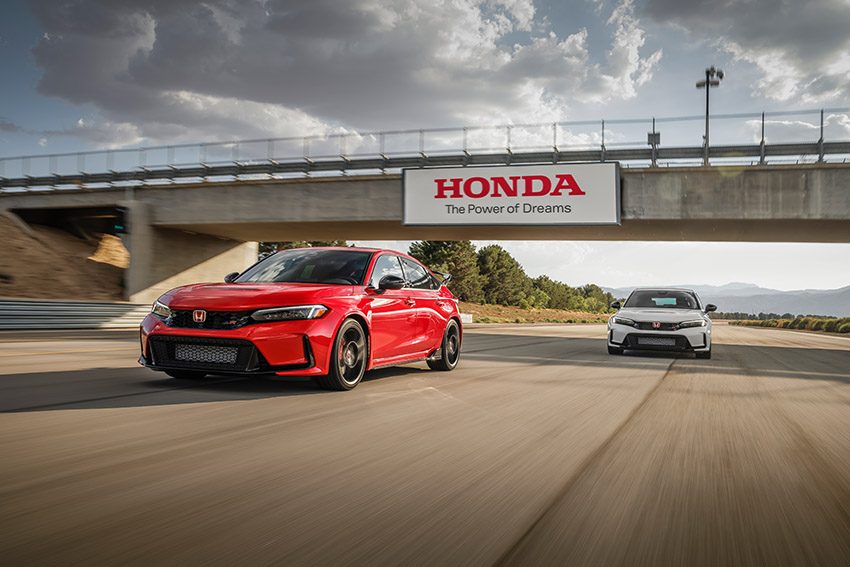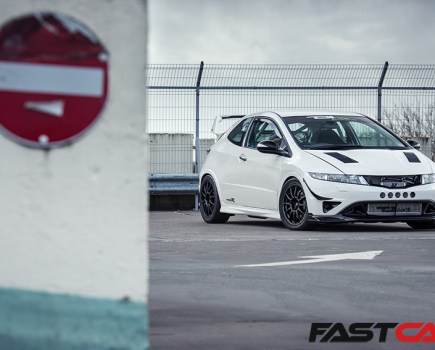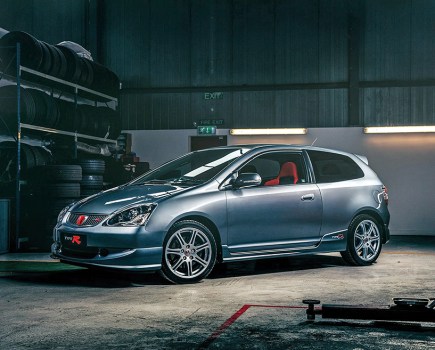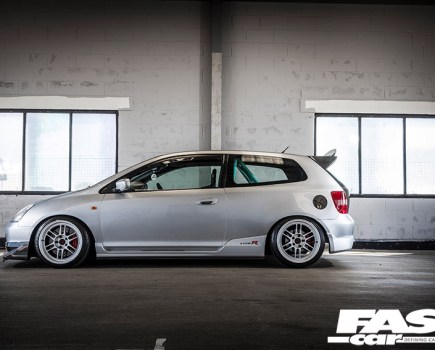For 26 years, Honda has been competing at the very top of the hot hatch game. Here’s your complete Honda Civic Type R guide, covering all six generations so far…
Best known for their love-them-or-hate-them VTEC engines, the Honda Civic Type R is a hugely popular vehicle to modify, across all of its iterations. These little front-wheel drive pocket rockets are bundles of fun even in stock form, and have plenty of untapped potential locked away. Luckily, the aftermarket is more than happy to release those extra performance gains, if you wish to chase them.
So, if you’re looking for a relatively affordable, sporty car that’s still fairly practical, you can’t really go wrong with a Type R.
Here’s our Honda Civic Type R guide to help you identify the different generations.
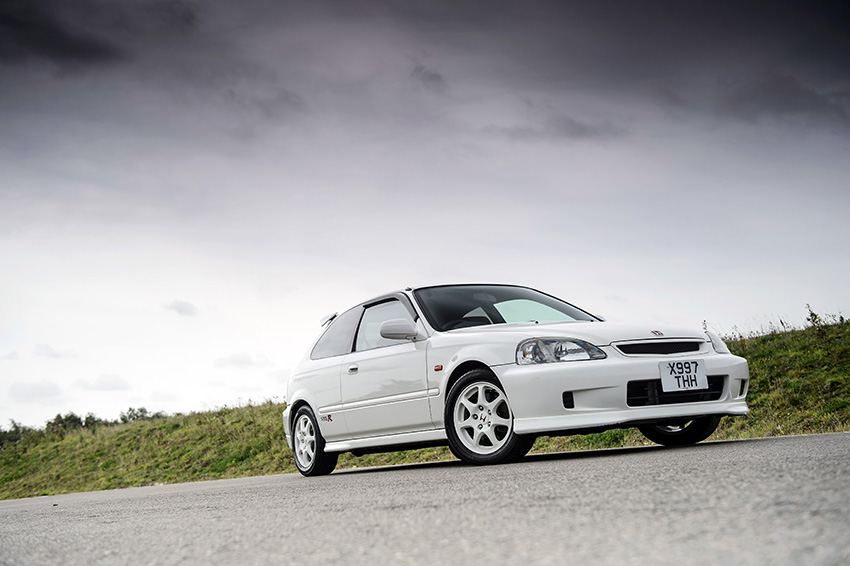
Honda Civic Type R EK9
The mathematicians amongst you will have figured out by now that the Type R’s story begins back in 1997. That was the year that the EK9 generation Type R made its public debut. In the mid-nineties, Honda was making waves in the performance car scene thanks to its NSX supercar. The hype around the NSX was so large that Honda decided to release a selection of more attainable Type R based on the DC2 Integra. Then it was the turn of the unassuming Civic hatchback.
The EK9 Civic Type R was only sold officially in Japan’s domestic market, but word of its ability spread. A 1.6-litre DOHC VTEC four-cylinder engine, designated ‘B16B’, equipped the EK9 with 182hp at 8200rpm. The peak torque figures reached similarly high up the rev range, with the 7500rpm point offering 118lb/ft. On paper those numbers might not sound that impressive. However, in a vehicle which weighed just 1050kg, that was more than enough grunt. In fact, in ‘horsepower per liter’ terms, the B16B was one of the highest-performing naturally aspirated engines of its era. 0-60mph came in at 6.7 seconds and top speed was over 140mph.
Chassis perfection
It wasn’t just the case of slapping a quick engine into a regular old Civic though. The front end got a helical limited slip differential; both ends of the car benefitted from double wishbone suspension. The chassis was a seam-welded monocoque, thus greatly improving rigidity over the standard Civic. Although it may look relatively nondescript, the EK9 had the technology to give it driving dynamics that any entry level sports car could be proud of.
The way it handles, and the way it goes, shines through in the design of the cabin. Bright red Recaro bucket seats not only get the pulse racing, but they also hug you tightly. And as for the gearbox, the short titanium stick is simply delightful to use.
Naturally, it wasn’t long before Japan’s illustrious tuning industry got its hands on the EK9. One of the most well-regarded examples of this was the upgrade package offered by Spoon Sports. In addition to a carbon fiber bonnet, the EK9 also received a new ECU, amongst other less publicized tweaks. Spiritually, it felt like the final evolution of all those modified EF9 and EG6 Civics used by the infamous Kanjozoku.
Pros of the Honda Civic Type R EK9
- High-revving, VTEC-equipped B16B engine
- Lightweight, with fun handling
- A real collector’s item
Cons
- Potential for rust
- Weak engine mounts
- Very rare outside of Japan
Common Problems
- Sticking rear calipers
- Smoke from the exhaust (valves seals or piston rings)
- Leaking rear light seals
Verdict
Unless you’re based in Japan, you’ll probably need to import an EK9 from its homeland if you want to get your hands on one. Prices start at around $15,000 / £12,000 for ropey examples, and stretch all the way up towards the $30,000 / £25,000-mark. When you consider the sort of prices that other JDM favorites are demanding these days, that actually seems fairly reasonable.
For many, this original Civic Type R is the ultimate example, so we’ve put together a handy EK9 Type R buyer’s guide to help you buy a good one. Look no further than our EK9 tuning guide for tips on how to get the most from that 1.6-litre engine. Or, take a look at one of our modified EK9 Civic Type R features for some inspiration before modifying.
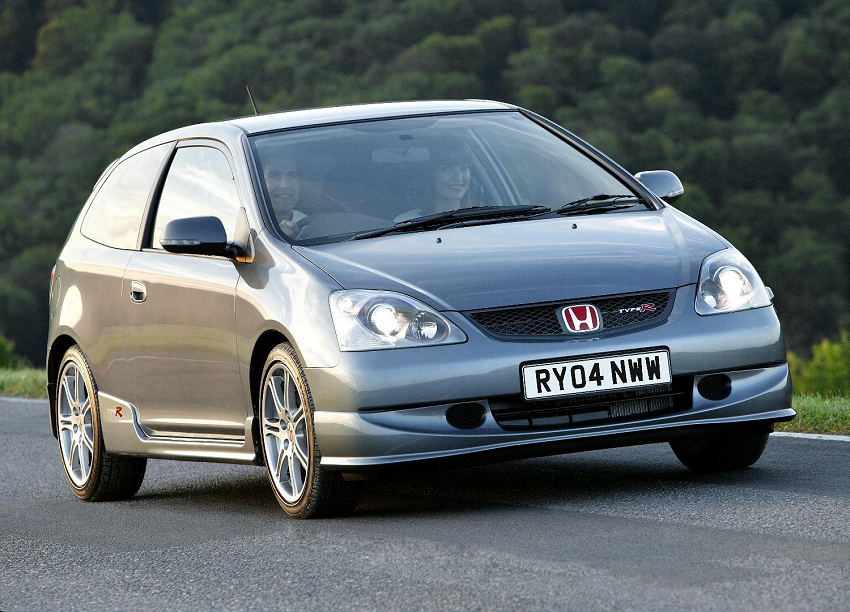
Honda Civic Type R EP3
That promised sequel came in the shape of the EP3. For the Civic Type R’s second iteration, production increased to fit demand from Europe. As a result, manufacturing shifted to Honda’s Swindon plant in the UK. However, unlike some of your favorite indie bands, none of the magic vanished by going mainstream.
The EP3 Type R debuted in 2001; the headline being a brand-new engine, which was a bold move considering how adored the B16B was. In its place though, the 2.0-liter DOHC i-VTEC K20 unit surpassed expectation. In fact, Honda’s line of K-Series engines would go on to reach an even greater level of ‘icon status’ than B16B.
Admittedly, the changeover into the ‘VTEC Zone’ wasn’t quite as explicit as in the old motor. However, the K20 was still nonetheless a riot to use. The new engine brought in 197hp for the European market. While the Japanese version got as much as 212hp. It was durable too. Check the classifieds today, and you’ll come across a hoard of EP3s with way more than 100,000 miles on the odometer. And that’s despite the track days and B-road chases that they would’ve undoubtedly gone through in the past.
Handling
Handling-wise, the EP3 picked up where the EK9 left off. In this sense, the Japanese EP3’s firmer chassis marked it out as the one to have. Not to snub the European-spec variant. Compared to the old EK9, even the European EP3 enjoyed an 80% increase in torsional rigidity. This was thanks to the use of high-tensile steel in its underpinnings.
Electric power steering was another new trick up the Civic Type R’s sleeve. Though, being a fairly primitive iteration of the technology, it won’t be to everyone’s taste nowadays. Nevertheless, there were struts at the front and a nifty multi-link suspension set-up at the rear. It also had a minimal 1200kg curb weight, which gave the car a puppy-like playful charm through the corners.
An extra cog meant that you now had six speeds to play with in the close-ratio manual gearbox too. The dash-mounted positioning of the gear lever falls effortlessly into hand over time.
Pros of the Honda Civic Type R EP3
- Playful handling
- Well supported by the European & Japanese performance aftermarket.
- Relatively affordable
Cons
- Potential for rust, especially on facelift models
- Stock 200PS output might feel a little underpowered today
- Plenty of poorly-kept examples on the market
Common Problems
- Stretched timing chain
- Worn steering rack
- Worn seat bolsters
Verdict
If there was one area which might have stifled the EP3’s success, it perhaps would’ve been the way it looks. Personally, we’re fans of the EP3’s aesthetics, but we know that the love isn’t universal. That said, any surface-level doubters were soon silenced once they got behind the wheel of it. An instant hit when it launched, the EP3 enjoyed a fantastic reception.
Although still quite affordable, EP3 prices are beginning to rise (like pretty much everything else). That said, you can still pick up a decent example from around £5500. Aside from the pristine exceptions, the EP3 market tops out at around £9000-£11,000. Though, bear in mind, Japanese-market models are often more expensive than their European equivalents, as they have extra goodies such as a stock LSD.
The American market never received the EP3 Type R, and as they first started to roll off the production line in 2001, they aren’t yet exempt from the 25-year import rule either. So, if you want to bring one of these modern classics stateside, you’ll have to wait a few more years yet.
These days, the EP3 is still one of the most financially attainable Civic Type Rs, despite its strong reputation. It’s also started to gain more traction in the US, too, with hardcore enthusiasts looking into the back catalogue of Civic Type R genius.
Be sure to check out our EP3 buyer’s guide and tuning guide if you’re thinking about owning one. We’ve also featured plenty of modified EP3s over the years, so feel free to check those out too!

Honda Civic Type R FN2
With the bar set so high, it was always going to be difficult for the car that replaced the EP3. That task fell the way of the FN2, which from the offset divided opinion. The chunky, ‘spaceship-like’ proportions didn’t naturally evoke thoughts of sporting agility. Sadly, its 1320kg curb weight didn’t do much to quash their fears. After all, that’s more than 100kg heavier than the EP3.
Nevertheless, the FN2 Type R does still deserve some plaudits. It’s a slightly more cleverly packaged car compared to its non-Type R counterpart. Even the fuel tank moved beneath the front seats to improve interior space. The decision to switch the rear suspension to a torsion beam was less popular, but the car still handles better than many would have you believe. Then there’s the engine. The spec of K20 found in the FN2 produces a single extra horsepower over the EP3’s power unit.
The peak example of the FN2 platform is the one built by tuning house, Mugen. Just 20 were ever built, and all of them came to the UK. In this guise, the K20 engine was thoroughly revised to bump it up to 237hp. While the brakes, aero and suspension were all bespoke. So too were the 18-inch rims, which weighed in at around a third of the weight of the standard ones. Plus, as a nod to the car’s extreme intentions, it came with semi-slicks as standard. On a track, the Mugen elevated the FN2 experience to a whole new level, though as a road car, its ride was too harsh for UK roads. Despite this, its aggressive VTEC crossover and extra ponies revealed the potential within the FN2 Type R.
If you want the absolute best that this generation of Civic can offer, you have to look overseas…
Pros of the Honda Civic Type R FN2
- Playful handling, despite internet reputation
- The most affordable Civic Type R of them all
- Last of the naturally-aspirated breed
Cons
- Bulkier body, less sophisticated suspension than the EP3
- Controversial styling hampers visibility from inside
- Paintwork susceptible to wear
Common Problems
- Timing chain
- Valve clearances
- Gearbox synchro issues
Verdict
That is the beauty of the humble FN2 hatch. Sure, it has a few shortcomings, but it still represents fantastic value in today’s market. Often the cheapest Type Rs around, they’re a great way to get into the world of hot Civics on a tight budget.
So, if you’ve got around £5000-£6000 (or less!) to spend on a hot hatch, check out our FN2 buyer’s guide, and tuning guide. There’s some cool modified FN2s in our back catalogue as well!
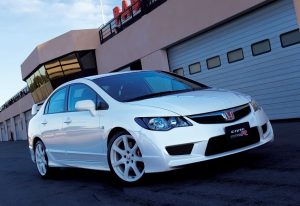
Honda Civic Type R FD2
Over in Japan, the third-gen Civic Type R was very different. Instead of the FN2 hatchback shape, Honda’s domestic market got a Type R based upon the FD2 saloon, which these days is far more desirable. Not just because of the aesthetics and the rarity, but because of its underpinnings. Their regular FD2 Type R had an extra 24hp under the hood compared to our standard FN2 Type R: to put that in perspective, that’s just five horsepower less than the bonkers Mugen FN2 mentioned above.
On top of that, the Japanese car had more powerful Brembo brakes, as well as a host of other set-up alterations which, to be brutally honest, make it a far more appealing prospect than the European version. Oh, and in case you were wondering, it too got the Mugen treatment. Known as the Mugen RR, only 300 were ever built, and every single one sold within ten minutes of the model going on sale.
Let’s be honest though, most of us in the Western part of the world are unlikely to be able to get our hands on a Mugen RR, or even a regular FD2 Type R. At least, not cheaply, anyway.
Pros of the Honda Civic Type R FD2
- Noticeably sportier than an FN2 when stock
- Will earn you a shed load of street cred
- Improved practicality of a four-door
Cons
- Overinflated price tag
- Harsh suspension set-up for everyday driving
- Scarce in the West
Common Problems
- Timing chain
- Valve clearances
- Gearbox synchro issues
Verdict
It’s not all sunshine and roses though. For British & European roads, the stock suspension is arguably too firm to be somebody’s daily driver. They’re expensive too – you’re looking at around £19,000 for a good one (roughly twice the cost, if not more, of an equal condition FN2). That’s partially because of the ‘JDM mystique’ and genuine performance credentials, but also partly because they’re simply hard to get your hands on in this part of the world. Oh, and if you’re based in the States, hard luck – these aren’t legal to import yet.
If you’re looking for more FD2 content, be sure to check out this head-to-head feature, where we pitch it against one of the UK’s best FN2s. Alternatively, check out this FEEL’s FD2 Type R.
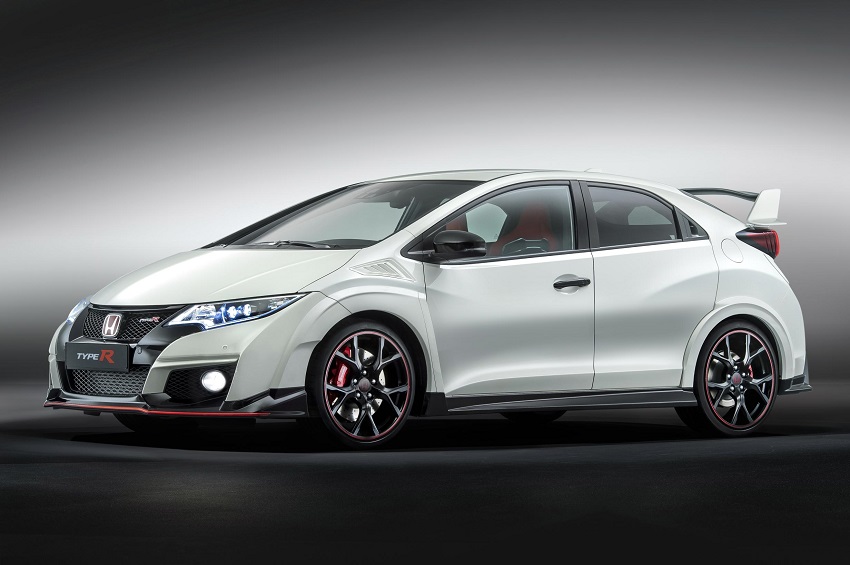
Honda Civic Type R FK2
Fast forward to 2015, and the automotive landscape is starting to look very different. With environmental regulations looming over Honda’s shoulders, the inevitable switch to forced induction arrived with the fourth-gen FK2 Civic Type R. Realistically, this was the only way to keep emissions down, but horsepower up.
However, instead of viewing turbocharging as a dilution of the Type R’s purity, Honda’s engineers embraced the tech to make it one of the FK2’s most appealing features. The resulting K20C1 engine developed 306hp – a staggering amount more than the FN2. What’s more, weight only increased marginally, meaning that the FK2 could offer a much more explosive driving experience.
To combat the newfound power, Honda introduced its Dual Axis Strut Suspension, which included a wider track and reinforced rear torsion bar. This, combined with a new limited-slip diff, would help the car to overcome torque-steer. Yet, despite all of these positives, the FK2 remains overlooked, and we think we might know the answer as to why.
Aggressive styling
When lined up against the rest of the Type R bloodline, the FK2 looks a bit like an adolescent dog that hasn’t quite grown into its big pointy ears yet. It’s still recognizably a Civic Type R, just a bit gawkier in some areas. The aggressive splitters and obnoxious rear wing, for example, just don’t seem to match the rest of the bubbly silhouette. Unfortunately, there’s no other way to describe it than the awkward middle ground between the soft, round FN2, and the frivolously aero-adorned FK8 (more on that, next!)
It’s a shame really, because what lies beneath the bodywork is a genuinely brilliant piece of engineering. The introduction of turbocharging opened the doors to a definitive new chapter in the Type R history book. All of a sudden, a Honda Civic was capable of 168mph flat-out, and it had a much more usable powerband along the way to that figure too. Peak power arrived 1000 revs earlier than in the FN2, while maximum torque (which stood at double the amount offered in the old car) was on tap from just 2500rpm compared to 5500rpm. What’s more, an individual oil cooler for the gearbox ensured that the FK2’s transmission could keep up with the extra mechanical demand when used on track.
It perhaps shouldn’t come as a surprise then that the FK2 Civic was the basis of many successful racing cars. It won multiple titles in the British Touring Car Championship, and had it not been for a freak testing accident, Tiago Monteiro probably would’ve claimed an FIA World title with his FK2 in 2017.
Pros of the Honda Civic Type R FK2
- 310PS from the factory
- Seriously quick, surprisingly economical if you behave
- Relative exclusivity (only 2-year production period)
Cons
- Muted engine tone compared to earlier cars
- Lacquer problems on wheels and calipers
- Quite pricey as a result of scarcity
Common Problems
- Head gasket failure & Overheating
- Loss of boost pressure
- Gearbox issues
Verdict
Overall then, the FK2 Type R maybe doesn’t get the recognition that its underlying engineering deserves. However, nobody seems to have told the used market that, as prices for these cars are still surprisingly strong compared to its predecessors…
Given the lesser age and higher performance potential of these cars, the FK2 naturally warrants a slightly higher price tag. £20,000 is the sort of number your looking at for an average example, with the best of the bunch demanding up to £25,000. Sadly these cars were never officially brought to the US, so if you’re looking to import one, hard luck, they aren’t legal yet.
Looking to buy one? Head over to our FK2 Type R buyer’s guide. If you’re already the proud owner of one, check out our Honda Civic Type R FK2 tuning guide for advice on what mods you should buy to make the most out of your FK2. And if you want to see what we thought of a stock one when we got behind the wheel, you can also read our FK2 car review .

Honda Civic Type R FK8
If the FK2 has flown under the radar, the fifth-gen Civic Type R certainly didn’t. The FK8 took on a much sleeker silhouette, and with it a large array of highly divisive aero parts. Some liked the unashamed aggression of the car’s design, whereas others felt it was far too ‘boy racer’ fresh from the factory.
Whatever you think of the way the FK8 looks, you can’t deny that it’s a fantastic vehicle to drive. Arriving in 2017, the FK8 came with new adaptive dampers to improve its handling, and a higher output K20C1; 316bhp to be precise. That wasn’t quite the case in the US though; instead, the power figure across the pond remained at 306hp. This was, however, the first time that a Civic Type R would officially be sold in America.
A flat underfloor worked in unison with all those wings and splitters to give the car exceptional downforce, which translated well into grip. Nürburgring lap records soon tumbled at an impressive rate. To this day, it remains the second-fastest front-wheel drive road car to ever lap the Green Hell, with a time of 7 minutes 43.8 seconds. In a wider context, that’s just two seconds slower than a Porsche 997 GT3 piloted by World Rally champion Walter Rohrl. Bonkers.
Mid-life update
Honda still saw room for improvement though, so in 2020, they fitted a larger radiator and bigger grille to go with it. The brakes also got an upgrade – not only making them able to withstand more hardcore track use, but also giving you some extra feel through the pedal. At the same time, refreshed damping coped even better with sharp cornering, while the gearstick – a key touchpoint for the driver – was given an ergonomic redesign.
Scarce variants of the updated FK8 soon followed, one of which being the imaginatively named Limited Edition. Only 20 came to the UK, all of which boasting an unmissable yellow paint scheme and some significant weight loss. Then, there was the Type R Sport Line. Clearly, Honda hadn’t been deaf to the complaints about the FK8’s ‘immature’ styling, and so the Sport Line remedied that. The big rear spoiler got ditched for a subtler one, and on the inside the bright red upholstery was swapped out for a calmer shade of grey.
Pros of the Honda Civic Type R FK8
- One of the best FWD performance cars ever
- Global availability and aftermarket support
- Aggressive aero?
Cons
- Muted engine tone compared to early N/A cars
- Sensitive to alignment
- Aggressive aero?
Common Problems
- Second-gear grind
- Infotainment system crashes
- Brake rotors/discs cracking
Verdict
Whichever side of the styling debate you stand on, the FK8 is widely considered the most dynamically adept hot hatch on the market.
Interested in buying one? Prices start at around £22,000 in the UK and rise to £35,000 for super low-mileage examples. There are a few special editions that demand north of 50 grand too, but unless you’re a collector or a die-hard Civic fan, we wouldn’t advise spending that much. As for our Stateside readers, the FK8 was the first generation of Honda Civic Type R to make it into North America officially. As a result, FK8s tend to be a bit more expensive. $28,000 is the rough starting point for FK8s in the US, but it’s not uncommon to see them listed for as much as $45,000-$50,000 at the top end.
Be sure to check out our FK8 buyer’s guide, tuning guide, as well as our review of it and modified FK8s we’ve featured, as well!
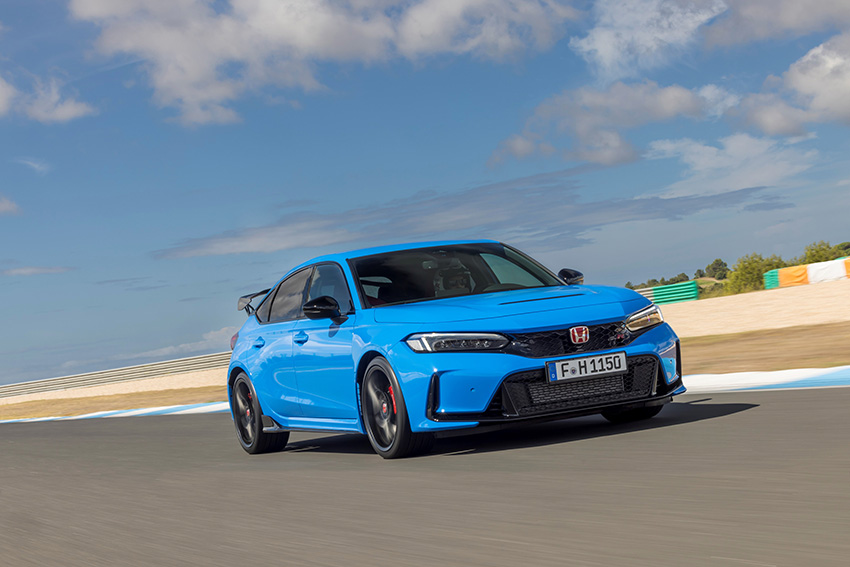
Honda Civic Type R FL5
If any car can knock the FK8 off its throne, it might well be this one. The FL5 Civic Type R is the latest and – hopefully – greatest hot hatch to roll off the Honda production line.
First things first, let’s tackle the biggest gripe that people had about the old car: the exterior design. Happily, it’s good news! The FL5 has certainly reined things in a little, and to our eye at least, has become a more attractive car as a result. It’s still a sporty little number thanks to a lower and wider stance than the previous car, but it carries itself in a manner which isn’t going to make its driver feel self-conscious every time they pull up at the lights. Of course, aerodynamic aids like splitters and spoilers remain a key feature, but everything has been dialed down just a smidge. And that’s a good thing.
Tech-wise, the changes made are largely incremental. A more compactly packaged turbo and high-efficiency exhaust should help to improve the car’s power-to-weight ratio, while a new rev-matching system and lighter flywheel aim to further reward spirited drivers. Honda are also promising a better sound out of the back of the Type R’s three central exhaust pipes.
FL5 Specs and Price
All in all, these little alterations have bumped the Civic’s power figures up to 324hp and 310 lb ft of torque. Well, that’s the case in Japanese and UK market cars, at least. In the US, hot hatch enthusiasts will be 4 horsepower down compared to those overseas.
On the road, the beefiest engine should allow this front-wheel drive hatchback to reach 62mph in just 5.4 seconds, meanwhile the top speed is pegged at a barmy 171mph!
As far as the car’s dynamics go, the usual array of ‘driving modes’ return in the FL5 too. However, the addition of a new ‘Individual Mode’ should give keen drivers the most customizable set-up options ever seen in a Civic Type R. Each of these different modes allow the driver to adjust the car’s steering, suspension, and various elements of the engine’s performance.
You’ve got to admit, there’s an awful lot to like about the latest entry into the Type R history books. But it’s not all sunshine and roses. There is one rather large downside.
Pricing starts at $43,990 in the US, and £46,995 in the UK. Let’s be honest, that’s *a lot* for a Honda Civic. In fact, that’s about ten grand more than the FK8 cost when it first launched. We’re sure these will sell in big numbers regardless, but still, a price hike that big seems a bit cheeky considering you’re pretty much just paying for refined FK8 tech in a prettier package.
To see if it’s worth the extra cost, have a read of our hands-on FL5 review.
Keen to dive further down the Honda Civic Type R rabbit hole? Check out the best modified Honda Civic Type Rs we’ve featured or brush up on some Civic trivia to impress your mates with.

